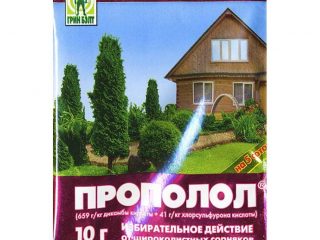Content
A beautiful green lawn is the calling card of a personal plot, and it can be a shame when annoying weeds grow through green grass and spoil the entire appearance of the landscape. You can control weeds in your lawn mechanically or using a chemical called a herbicide. This weed killer on the lawn is highly effective, easy to use and some other advantages. Information on what types of lawn herbicides there are and how to use them correctly can be found in the article below.
What are herbicides
For many people remote from agriculture, the word “herbicide” is completely incomprehensible, and the product itself is not used very often in everyday life. This word is translated from Latin as “to kill grass.” A substance is a chemical that destroys weeds. It can be used to protect vegetable beds and lawns from unwanted vegetation. On an industrial scale, herbicides are used to treat agricultural fields, slopes of railway and highway tracks, and areas adjacent to enterprises.
Based on the principle of their effect on vegetation, herbicides are divided into:
- Selective or selective spectrum of action. They are capable of destroying all types of plants with a certain trait, for example, broad-leaved grasses.
- Continuous spectrum herbicides destroy all vegetation in the treatment area.
Weed control in your lawn can be done using these two types of herbicides. The method of their use and the principle of influence are different, so you need to know and understand how this or that chemical will fight weeds on the lawn.
Weed control at distant approaches
Properly growing a lawn with pre-treatment and proper soil preparation will allow you to get a beautiful green lawn and not have to worry about how to remove weeds at an early stage of crop care. It is necessary to prepare the soil in advance, approximately 3-4 months before the intended sowing of lawn grass. For such pre-treatment, continuous action herbicides are used.
The work technology is as follows:
- Initially, you need to mark out your personal plot, determining the location of the lawn;
- After marking, the future lawn is generously watered with a continuous chemical. About a week after treatment, the existing vegetation will begin to dry out, and after another week the area will need to be dug up, removing weeds and roots remaining in the soil;
- the loose soil is compacted a little and left in this state for a month, during which the weeds remaining in the soil should appear;
- after the germination of a new crop of weeds, the soil is watered again with continuous herbicides and after a week the dry remains of vegetation are removed;
- The chemical acts on plants for a month. Only after this time can you start sowing lawn grass, which will germinate without weedy “neighbors”.
It is recommended to treat the lawn before sowing grass using the above technology in early spring or autumn, starting in September. Tilling the lawn in the fall allows you to reliably clear the soil of weeds before the snow cover appears, and with the arrival of spring, sow grass seeds into the soil without chemical residues.
Green lawn care
By sowing lawn grass in prepared, cleaned soil, you can get a high-quality, leveled lawn, however, you can preserve its beauty and health only if you follow certain care rules:
- Lawn mowing is a must. It allows you to improve the planting of herbs and mow down weeds. Annual weeds, when regularly mowing the lawn, do not have time to form flowers and sow seeds, which means that next year there will be no “harmful neighbors” on the site. It is recommended to mow young lawn grass for the first time after the height of its leaves exceeds 7 cm. Subsequently, the event should be carried out regularly once every 2 weeks.
- Combing the lawn with a rake allows you to identify and destroy low-growing climbing weeds that are located below the cutting level. Such weeds may be, for example, bindweed or woodlice. It is to combat climbing and climbing grasses that owners of their garden plots comb the lawn not only after using a trimmer to collect remnants of vegetation, but also after mowing the grass with a lawn mower.
- Most perennials have a deep, highly developed root system and it is not always possible to combat them by mowing and combing the lawn. Thus, it is especially difficult to remove dandelions, sow thistle or plantain from the lawn. These enemies can be combated mechanically by removing plant roots manually. For this you can use a special garden weed removal equipment. It will allow you to get rid of unwanted vegetation with minimal damage to the lawn grass. The mechanical method of control is good only if the number of weeds is small.
- Moss often affects areas of the lawn in the shade of trees or in low-lying areas. Wet weather can also provoke their development. The spread of moss should be controlled by aerating the soil. This can be done by piercing the lawn with a pitchfork. Liming and fertilizing the soil will also help prevent the spread of moss in your lawn.
- If there are a large number of weeds, it is recommended to treat the lawn with selective herbicides. Chemical treatment will take little time and will be highly effective in controlling weeds. The names and photos of selective and continuous action herbicides can be seen below.
Over time, the number of weeds on the lawn will constantly increase. This is due to the fact that there are a large number of seeds in the soil, which strive to germinate and shade the green grass.Therefore, in the first year of growing a lawn, you can only get by with methods of mechanical destruction of weeds, but over time it will become more and more difficult to fight them. The absence of measures to destroy weeds will lead to the complete displacement of cultivated vegetation. That is why, over time, the use of selective herbicides is becoming increasingly important.
Continuous herbicides
As has already become clear, continuous action herbicides destroy all vegetation on the lawn, which means they can only be used during the period of preparing the soil for sowing grass seeds or to destroy old plantings. The most effective and safe, from an environmental point of view, continuous action herbicides are:
Tornado
This chemical is an aqueous solution of glyphosate. The drug is produced in ampoules with volumes from 5 to 1000 ml. The substance is used to spray plants with a solution prepared on a water basis. Depending on the exact name, the drug "Tornado" is diluted in accordance with the instructions.
After using the Tornado herbicide, all vegetation on the lawn will be destroyed within 3 weeks. The drug itself will remain in the soil for 2 months.
Herbicide "Tornado" can be used at any air temperature and weather. At the slightest contact with the leaves of a plant, it penetrates deep into the root, gradually destroying it. Using the Tornado herbicide, you can get rid of not only weeds, but also shrubs and tall trees.The chemical is used in the agricultural industry, since the lack of toxicity makes it possible to sow vegetable crops the very next year after processing the fields. If necessary, Tornado herbicide can be stored for 5 years. Analogues of "Tornado" are the drugs "Glisol", "Urogan", "Agrokiller" and some others.
Diquat
This herbicide is based on the substance of the same name – diquat. It is safe for the environment and humans, and can be used for continuous mowing of grass for sowing cultivated plants. The chemical is used for spraying plants at temperatures +15-+250C. The substance affects plants immediately after contact with green leaves or soil. You can see the result of the treatment in 4-7 days. Air temperature and humidity can affect how long it takes for herbs to dry out.
Weeds are removed from the lawn by spraying with an aqueous herbicide solution. Once on grass leaves, diquat is synthesized into hydrogen peroxide, which destroys plant cells and dries them out. The chemical decomposes quickly and does not harm insects or soil microflora.
Broadcast herbicides can be used before seeding lawn grass or to remove all turfgrass from a lawn. If you decide to develop land on the site of a lawn for the subsequent cultivation of cultivated plants, then it is preferable to use a less toxic preparation that will not damage the quality of the grown vegetables and berries.“Dikat” is the best option for such purposes, however, its disadvantage may be its relatively low effectiveness in controlling weeds.
An overview of some other effective herbicides of continuous and selective action can be seen in the video:
Selective herbicides
How to kill weeds on your lawn without damaging the tender green grass? This is the question that puzzles many land owners. And in this case there can be only one answer: you need to use selective herbicides. Among these chemicals, the following drugs are highly effective:
Lontrel 300
The active ingredient of the drug is clopyralid, a hormone that limits the growth of weeds and destroys them. The drug is highly effective in controlling annual and perennial weeds, including dandelion, sedge, and plantain.
The herbicide should be used after mowing the lawn early in the morning or after sunset. The substance is applied by spraying onto the above-ground parts of plants. The substance is quickly absorbed, and you can see the result on the treated weeds within 2 weeks.
Deimos
Treating the lawn against weeds with Deimos allows you to remove hated broad-leaved plants. The spectrum of action of this drug allows you to eradicate about 100 different types of weeds at once. Weeds such as woodlice, clover, dandelion and others cannot resist it.
The active ingredient of the drug is dimethylamine salt, which is safe for plants and humans. After dissolving in water, the chemical is used to spray the lawn. After just 2 weeks, the weeds will dry out and will no longer spoil the green lawn.They can be removed mechanically without much difficulty.
Hacker
This herbicide for lawn grass is relatively new, but is already widely popular due to its high effectiveness in controlling many weeds. The active substance of the chemical penetrates the leaf blade of the plant and blocks its growth. As a result of this effect, within a week the weeds turn yellow and dry out, while the lawn grass remains healthy.
The given selective action herbicides for lawns against weeds are characterized by high efficiency and environmental safety. They can be used to treat lawns, including playgrounds, parks, and personal plots. Their safety is confirmed by the fact that they can be used not only to remove weeds from the lawn, but also from beds with vegetable and berry crops.
You can see the process of treating a lawn with selective herbicides in the video:
Conclusion
Weed control on the lawn using herbicides is an effective and relatively simple way to care for vegetation. Herbicides are used from the moment the soil is prepared for sowing lawn grass seeds until the lawn is completely destroyed. For the complete destruction of grasses, the herbicides “Tornado”, “Diquat” and some of their analogues should be used. These chemicals will quickly deal with all the vegetation on the lawn. In the first year of growing a lawn, single specimens of weeds can be found on the green surface.They can be destroyed mechanically or with a targeted injection of herbicide at the root of the plant. When weeds are widespread, it is recommended to use selective herbicides that will destroy the weeds but will not damage the green soil cover. The specific choice of what to treat the lawn against weeds depends on the financial capabilities and preferences of the landowner.






















